Winchester, Hampshire, England, UK 作者: 来源: 发布时间:2021-07-27
I. Population and Area
Continent: Europe
Country: The U.K
State/Province: England
City/Town: Winchester, Hampshire
Total Area: 55.4 (sq mi)
Population in 2018: 116.6 (thousand)
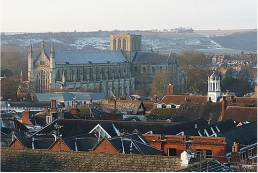
II. Natural Geography (environment and resources)
Climate
As with the rest of the UK, Winchester experiences an oceanic climate . The nearest Met Office station is in Martyr Worthy, just outside the city. Aside from the city centre, there are several suburbs and neighbourhoods within the city, including: Abbotts Barton, Badger Farm, Bar End.
Road
Winchester is located near the M3 motorway and at the meeting of the A34, A31, A3090 and A272 roads. Once a major traffic bottleneck, the city still suffers from congestion at peak times. It is just to the south of the A303 and A30.
Bus services
Local, rural and Park and Ride bus services are provided by Stagecoach South, who run to Andover, Alton, Basingstoke, Petersfield, Romsey and Fareham. Bluestar provide services to Eastleigh and Southampton. Many services are subsidised by Hampshire County Council and community transport schemes are available in areas without a regular bus service.[citation needed] National Express coaches provide services mainly to Bournemouth, Poole, Portsmouth and London.
Rail
Winchester railway station is served by South Western Railway trains from London Waterloo, Weymouth, Portsmouth and Southampton, as well as by CrossCountry between Bournemouth, and either Manchester or Newcastle via Birmingham. Historically it was also served by a line to London via Alton, which partially survives as the Watercress Line. The closure of this line removed an alternative route between London and Winchester when, due to engineering works or other reasons, the main line was temporarily unusable. There was a second station called Winchester Chesil served by the Didcot, Newbury and Southampton Railway, this closed in the 1960s. This line provided a link to the Midlands and the North, bypassing the present longer route through Reading.
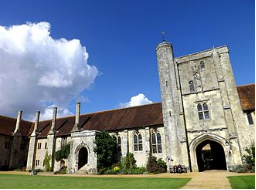
III.Ecocomy
Total Gross Value Added for Winchester was £4,823 million in 2015, having grown by 22% between 2011 and 2015. GVA per head has also shown growth in recent years – by 18% to £39,693 in 2015.
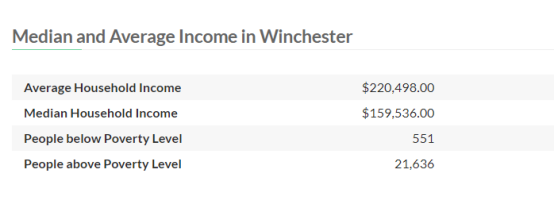
Reference Website:
https://www.google.com/search?ei=WwZSX_SQIeK80PEPxp2B2A4&q=gdp+of+Winchester%2C+Hampshire&oq=gdp+of+Winchester%2C+Hampshire&gs_lcp=CgZwc3ktYWIQAzIFCCEQoAFQn6vBAVifq8EBYMiswQFoAHAAeACAAYUCiAGFApIBAzItMZgBAKABAqABAaoBB2d3cy13aXrAAQE&sclient=psy-ab&ved=0ahUKEwi0qonMlc_rAhViHjQIHcZOAOsQ4dUDCA0&uact=5
https://www.point2homes.com/US/Neighborhood/MA/Winchester-Demographics.html
IV. Industrial Characterisitics
Major industries:
creative and media industries

References to the economy in parts 1 and 2 of the current Winchester District Local Plan support this approach. They identify the employment sectors for Winchester that are important and should be encouraged: education from primary to university level, creative and media industries, the professions and knowledge-based activities. All these the Trust supports as being important for Winchester.
The future of the retail sector, both nationally and locally, is difficult to predict. A significant decline in the number of shops would have a significant impact on the character of the town centre. One asset that Winchester has in abundance is its heritage. The contribution that this can make to the local economy needs to be nurtured and developed.
The Trust believes that new thinking should be given to the future of the retail economy and the opportunity to develop the economic potential of heritage-related activity.
Major projects and related introductions:
Central Winchester Regeneration
There have been some exciting developments and improvements made with the regeneraton of central Winchester since the project was re-started with a community planning weekend in March 2017. Since then the council has engaged with the community and other stakeholders to create a vision for the area. The site is 4.5 hectares including the bus station, the Broadway; the former Friarsgate Medical Centre; St Clements Medical Centre; Kings Walk; Friarsgate Car park; the former antiques market building and Woolstapler's Hall. After a detailed and extended period of consultation the Supplementary Planning Document (SPD) which sets out the vision for the Central Winchester Regeneration project which was approved in June 2018. You can access and download the SPD via the documentation web link. Since the SPD was approved, work is taking place to bring parts of the site to life and the Council is working with strategic place making consultants, JLL to produce a development framework and delivery strategy for the whole area.
Reference Website:
https://www.cityofwinchestertrust.co.uk/economy
https://www.winchester.gov.uk/projects/5744/central-winchester-regeneration
V. Attractions
1. Winchester Cathedral:
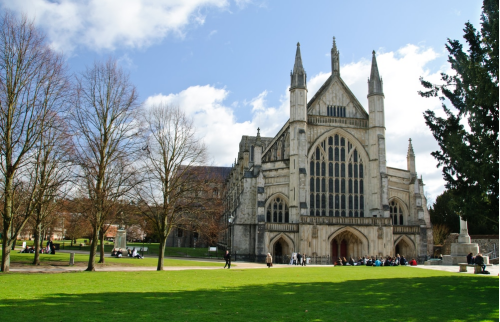
The stupendous Winchester Cathedral is more than 170 metres long, making it the longest Gothic cathedral in Europe. It was founded in 642 and work began on a new structure in 1079 following the Norman Conquest. This survives in the basic dimensions of the nave, the transepts and the crypt, while the tower had to be replaced in the early 12th century after collapsing. At the turn of the 15th-century the nave was given its Perp
2. Hospital of St Cross:
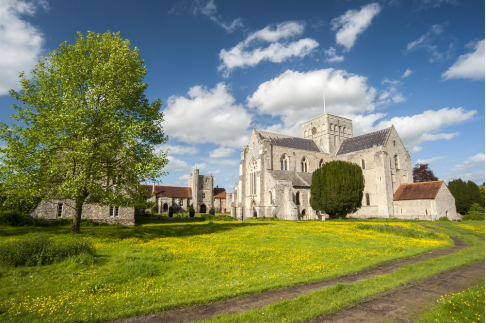
Winchester has the largest Medieval almshouse in the UK, set in the 1130s when Henry of Blois was Bishop of Winchester. The Hospital of St Cross resembles a college at Oxford or Cambridge in the way it is constructed on quadrangles. It remains a functioning private foundation, home to 25 brothers, but welcomes the public on visits.
3. Winchester College:
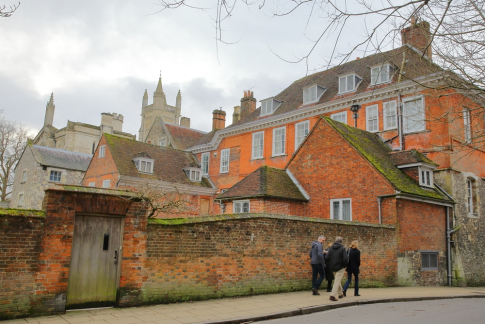
Established in 1382, Winchester College may be the oldest continuously running school in the UK, and is certainly the oldest of England’s seven Public Schools. It has been located at its present site for over six centuries, so you may not want to miss the chance to see inside an institution with this kind of history. As a functioning school, visits are by guided tour only, and these take place all year round at set times (normally twice a day) from Monday to Sunday.
Reference Website:
https://www.thecrazytourist.com/15-best-things-to-do-in-winchester-hampshire-england/
VI. History
Prehistory
The area around Winchester has been inhabited since prehistoric times, with three Iron Age hillforts, Oram's Arbour, St. Catherine's Hill, and Worthy Down all nearby. In the Late Iron Age, a more urban settlement type developed, known as an oppidum, although the archaeology of this phase remains obscure.
The settlement became an important centre for the British Belgae tribe, however it remains unclear how the Belgae came to control the initial settlement. Caesar recorded the tribe had crossed the channel as raiders (probably in the 1st century BCE), only to later establish themselves in Britain. The Roman account of continental invaders has been challenged in recent years with scientific studies favouring a gradual change through increased trade links rather than migration.
Roman period
After the Roman conquest of Britain, the settlement served as the capital (Latin: civitas) of the Belgae and was distinguished as Venta Belgarum, "Venta of the Belgae". Although in the early years of the Roman province it was of subsidiary importance to Silchester and Chichester, Venta eclipsed them both by the latter half of the second century At the beginning of the third century, Winchester was given protective stone walls.[10] At around this time the city covered an area of 144 acres (58 ha), making it among the largest towns in Roman Britain by surface area. There was a limited suburban area outside the walls. Like many other Roman towns however, Winchester began to decline in the later fourth century.
Modern period
The City Cross (also known as the Buttercross) has been dated to the 15th century, and features 12 statues of the Virgin Mary, other saints and various historical figures. Several statues appear to have been added throughout the structure's history. In 1770, Thomas Dummer purchased the Buttercross from the Corporation of Winchester, intending to have it re-erected at Cranbury Park, near Otterbourne. When his workmen arrived to dismantle the cross, they were prevented from doing so by the people of the city, who "organised a small riot", and they were forced to abandon their task. The agreement with the city was cancelled and Dummer erected a lath and plaster facsimile, which stood in the park for about sixty years before it was destroyed by the weather. The Buttercross itself was restored by George Gilbert Scott in 1865, and still stands in the High Street. It is now a Scheduled Ancient Monument.
VII. Culture
Winchester Combined Court Centre consists of a crown court and county court. It is administered by Her Majesty's Courts Service, an Executive Agency of the Ministry of Justice. Winchester is a first-tier court centre and is visited by High Court judges for criminal and for civil cases (in the District Registry of the High Court). One of the most high-profile cases to be heard here was the murder trial of Rosemary West in 1995.
Winchester has a separate district probate registry, which is part of the High Court.This Court is separate from the main court establishment at the top of Winchester High Street and deals only with probate matters.
There is a heavily populated Victorian prison, HMP Winchester, opposite the hospital, on the B3040 heading up west from the town centre.
Since 1974 Winchester has hosted the annual Hat Fair, a celebration of street theatre that includes performances, workshops, and gatherings at several venues around the city. Winchester is the home of Blue Apple Theatre, a theatre company that supports performers with learning disabilities to develop theatre, dance and film productions. It won the Queen's Award for Voluntary Service in 2012. Winchester hosts one of the UK's larger farmers' markets, with about 100 stalls. It is certified by FARMA.The market takes place on the second and last Sunday of the month in the city centre.
Four newspapers are published for Winchester. The weekly paid-for Hampshire Chronicle, which started out in 1772 reporting national and international news, now concentrates on Winchester and the surrounding area. The Southern Daily Echo mostly concerns Southampton, but does also feature Winchester. It has an office shared with sister paper the Hampshire Chronicle. The Mid-Hants Observer is a free, weekly independent paper for Winchester and nearby villages. Its sister paper, the weekly Hampshire Independent, which covers the whole county, is also based in Winchester. The free Winchester News Extra closed in 2017.
VIII. Other information
City museum
The City Museum, located on the corner of Great Minster Street and The Square, contains much information on the history of Winchester. Early examples of Winchester measures of standard capacity are on display. The museum was one of the first purpose-built museums to be constructed outside London. Local items featured include the Roman Venta Belgarum gallery, and some genuine period shop interiors taken from the nearby High Street. Other places of cultural interest include the Westgate Museum (which showcases various items of weaponry), and the Historic Resources Centre, which holds many records related to the history of the city. In 2014 ownership of the City museum was transferred to the Hampshire Cultural Trust as part of a larger transfer of museums from Hampshire County Council and Winchester City Council
IX. Contact information
Mayor/Officer: Cllr Patrick Cunningham
Tel: 01962 840222
Mail: mayorssecretary@winchester.gov.uk
Reference Website:
https://www.winchester.gov.uk/councillors-committees/mayor-of-winchester/
